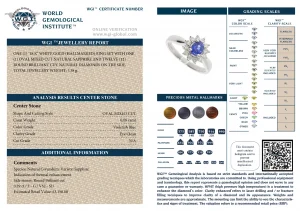What should a gemological report include?
A proper professional appraisal should have the following elements included:
1) Description
A description of the item that clearly describes the piece of jewellery in sufficient detail that someone reading that description can recognize the item. Simply stating “One ring with diamonds” for example is not sufficient. In fact, today, many insurance companies will not accept an appraisal without an adequate description.
2) Photograph
While not required, it makes it much easier to identify and replace the item once it no longer exists.
3) Value
The value conclusion should reflect the market. It should not be inflated, nor undervalued, as these would be detrimental to the client and could greatly affect premiums and settlements. The appraised value should be an amount that can adequately cover the jewelry should it be lost. Having a high value may make you feel good but generally will only increase your premiums while providing no additional coverage in a loss. It is not the dollar amount that protects your insured interest it is the thoroughness of the description that will be relied upon by an adjuster should a claim be made.
5) Treatment information
According to the Federal Trade Commission in the Unites States, almost all treatments – that is any process done to improve the appearance of a the gemstone other than cutting and polishing–needs to be disclosed to the consumer. If the seller has not done this, it may be in violation of the codes. Appraisals should also contain this important information. The jewellery industry tends to be lax regarding disclosure of treatments but not always to be deceitful. For example, since nearly every ruby and sapphire has been heat treated to improve colour, and this practice has existed for more than 100 years, jewellers tend simply to accept treatment as fact and do not disclose this information. However, the information should be given to the consumer. On appraisals, this information is also helpful to have because it is a value factor. Treatment information can be provided on the report directly or as part of addendums that some appraisers use.
6) Plotting or Laser inscriptions
A plot is a diagram of your diamond with the inclusions (both visible and microscopic) shown on it. That’s the gist of a plot. It’s like a drawing of your fingerprint with all the lines, curves and indentations.
7) Other documentation
Some appraisers will add several other forms of information to the appraisal. Limiting conditions may be included which discuss issues such as the limitations of fully grading diamonds or other gemstones if they are set into the jewelry. For example, the weights of the gems are only estimates or stated weights by the seller (if put on setting). Other information may include details such as treatment information and the appraiser’s qualifications.

